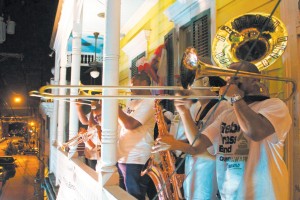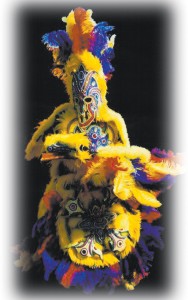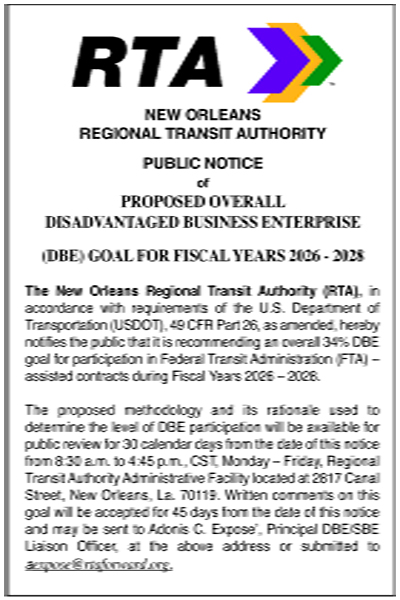Sharing New Orleans street traditions
12th March 2012 · 0 Comments
By Geraldine Wyckoff
Contributing Writer
The uptown Indian Super Sunday parade, presented by the Mardi Gras Indian Council on Sunday, March 18, kicks off with the Hot 8 and Soul Rebels brass bands fronting the Lady Buckjumpers Social Aid & Pleasure Club and the Young Men Olympian Jr. Benevolent Association leading the procession. All are one – Black Indians, brass bands and second line clubs – when it comes to New Orleans street traditions.
Their connection is always in evidence with many Mardi Gras Indians often in attendance at the Sunday afternoon social aid and pleasure club parades and with brass band and club members out in support of Black Indian functions. The strong ties between the Indians and brass bands are emphasized when considering those who are active in both traditions. Through the decades brass band musicians who’ve masked Indian include such well-known players as drummer Gerald French, trumpeter Kenneth Terry, trombonist/tuba man Walter Ramsey, drummer Ajay Mallory and trombonist Stafford Agee as well as jazz artists saxophonist Donald Harrison Jr. and drummer Idris Muhammad,

By no means are New Orleans Brass Bands synonymous with Mardi Gras Indians. But the number of brass band musicians who mask Indian is significant and many will take to the street in full regalia during the Indian Super Sunday parade on March 18. Among those is ReBirth trombonist Stafford Agee, above, and at far right, as Spyboy of the Black Feather.
Agee first became active with the Mardi Gras Indians helping Terry and drummer Ajay Mallory sew when they became members of the Black Feather gang. It wasn’t until 2002 that Agee masked for the first time. He became a spyboy for the Yellow Pocahontas then led by Big Chief Allison “Tootie” Montana.
“I fell in love with the whole way of life of the Mardi Gras Indians,” Stafford says. “For one it takes time for you to sit down and actually sew a costume. It takes patience. When I starting masking, that was something I was working on – patience. Once you put that entire suit together, you have a whole new respect for it (the Indian culture).”
Eager to fully embrace the full spectrum of the Indian experience, Agee decided to leave the Yellow Pocahontas. Getting on in age, Chief Tootie Montana no longer traveled uptown and downtown as he did in his younger days. So Agee began “running spy” for the Black Feather that was under the leadership of the recently departed Big Chief Lionel Delpit.
“The music and the drumming of the Indians are all spiritual and the brass bands have the same spiritual feel,” Agee offers. “To really play music it has to be embedded in your soul. The brass band music comes from going back down to Congo Square. The Indians have the same beat.”
Ajay Mallory, presently a member of the Forgotten Souls Brass Band and the 101 Runners as well as the New Orleans Sheriff’s Department, echos Agee’s sentiments..
“The common ground for Mardi Gras Indians and the brass bands is the rhythm, the music, the drums,” Mallory says. “A lot of the brass bands music, that’s from the Congo Square rhythms. It’s called clave. Most of the Indian chants are on the same beat like the traditional “Iko Iko” beat. You can play any brass band tune and sing an Indian tune to it also because it has the same structure.”
 Mallory’s involvement with the Indians came early in life. His uncle, George Palfry was the Chief of the original Yellow Jackets. As a small child, he would help in such tasks as pulling apart feathers. Growing up in the 5th Ward, Mallory was surrounded by the street cultures of second lines and Indians. Though he was always deeply involved in the Mardi Gras Indians and had uncles who ran with the Yellow Pocahontas, he didn’t mask until 1994.
Mallory’s involvement with the Indians came early in life. His uncle, George Palfry was the Chief of the original Yellow Jackets. As a small child, he would help in such tasks as pulling apart feathers. Growing up in the 5th Ward, Mallory was surrounded by the street cultures of second lines and Indians. Though he was always deeply involved in the Mardi Gras Indians and had uncles who ran with the Yellow Pocahontas, he didn’t mask until 1994.
“I finally got tired of just helping everybody,” he says. “I said, ‘You know what, I’m old enough, I have my own money, I’m going to make me a suit.’”
He took the position of flagboy with the Black Feather, a tribe that included Kenneth Terry. “It took 25 years of courage,” says Mallory, 43, of the span of time that elapsed before he finally put on a suit.
Mallory began drumming in the Gregory Junior High School Jazz Band and in 1988 he started playing with the Young Olympia Brass Band. (It eventually transformed into the Soul Rebels.) He hit the snare with the ReBirth from 1989 until 2001 when he became a longshoreman.
Mallory considers his position as a flagboy and that of a snare drummer as sharing similar qualities.
“When you see me, you know what’s coming,” Mallory says, explaining that he totes the flag that identifies the gang. When I played for ReBirth, if you heard my drums you’d know that ReBirth was coming down the street.”
Mallory’s style of sewing changed after he met up with a man he knew in Texas following Katrina. With the Black Feather, he always sewed in the three-dimensional style while this guy was using the beaded patch style. “I watched him and decided I wanted to start making beaded patch suits. On his return to New Orleans, he joined the Hard Head Hunters gang in 2006 while also performing with a host of brass bands. After that, he ran “renegade” taking to the streets by himself. Next year his plans are to be among those to put the White Eagles tribe back on the streets. Mallory’s wife was once a Little Queen of the legendary tribe.
While neither Mallory or Agee masked this year, both intend to be out at the Indian Super Sunday parade as well as on March 19, St. Joseph’s night. That’s when, like on Mardi Gras, the Indians roam the streets meeting other gangs both uptown and downtown.
“I’ll be there playing drums with somebody,” Mallory declares of the two events. “They’ll see me with jeans and a T-Shirt on and a feather in my head with a drum strapped around my waist. I haven’t missed a St. Joseph’s night since I was old enough to go out on my own.”
“It’s the best night the Indians have to come out,” exclaims Agee, who prefers the “free-for-all” tradition of St. Joseph’s night to the parade where there’s little interaction among the gangs.
“When you’re playing the role of an Indian on Mardi Gras or St. Joseph’s night it’s like a chess game. It’s not always who’s the prettiest. You can have somebody out there who’s playing with little or no bead work on their suit and if they’re really playing Indian they’ll beat you every time.”
Agee, who has an instrument repair business and volunteers at O. Perry Walker High School, finished the suit he planned to wear this Mardi Gras but because of the death of Chief Delpit he decided not to mask. He’ll use that suit for his two young sons and make a new suit for the 2013 Carnival.
“I believe I’m building a legacy that my family never had,” says Agee whose relatives were farmers. “Right now the kids want to mask Indian because I do it. As they get older they’ll learn more about the different traditions in New Orleans and Black history. They’ll learn what they’re doing. It’s important to continue and embrace that whole tradition.
“My favorite part for both is watching the expressions on people’s face,” says Mallory of working in brass bands and masking Indian. “It’s like ‘Wow, did he really play that?’ or ‘Wow did he really sew that?’ Once you start playing on those streets it’s like all the spirits from the elders and the past musicians take your body over.”
The Indian Super Sunday festivities begin at A.L. Davis Park at 11:30 a.m. with music continuing there all day with artists including BRW, Jo “Cool” Davis, DJ Captain Charles, DJ Jubilee and more. The procession takes off from the park at 1 p.m., makes a circle route traveling along LaSalle St. Simon Bolivar, Martin Luther King, S. Claiborne and Washington Ave. and returns to the park.
This article was originally published in the March 12, 2012 print edition of The Louisiana Weekly newspaper



